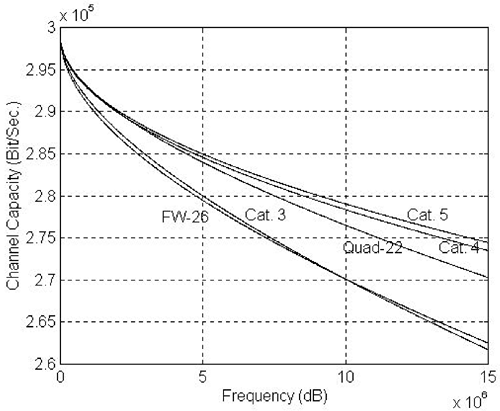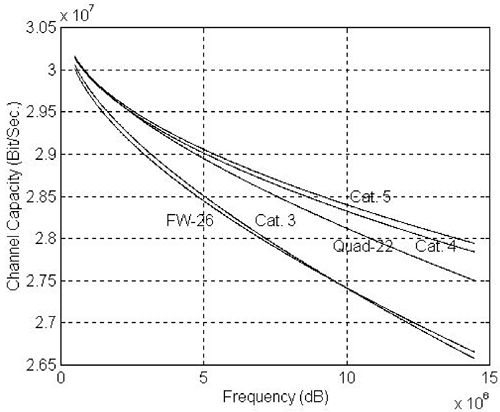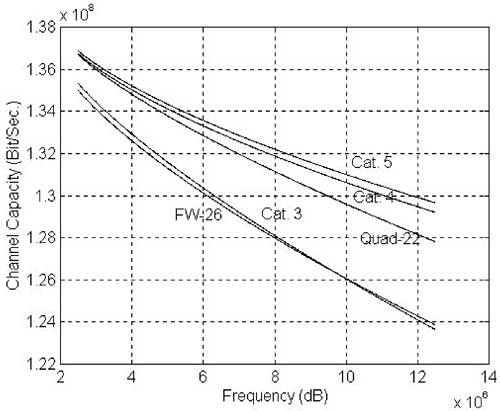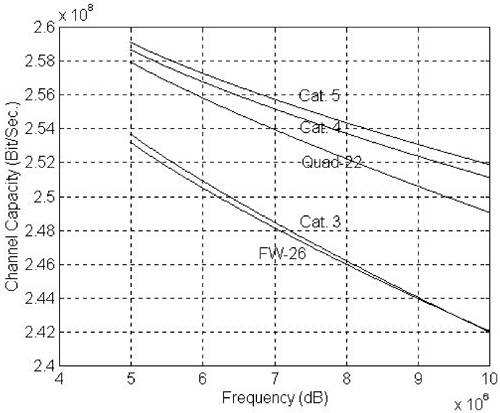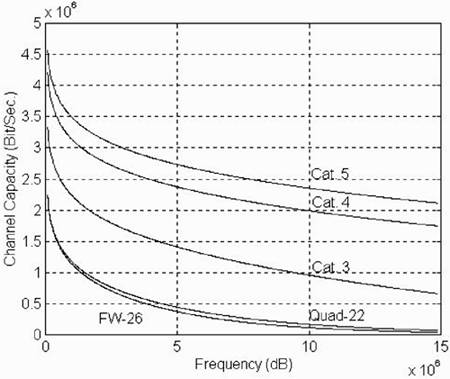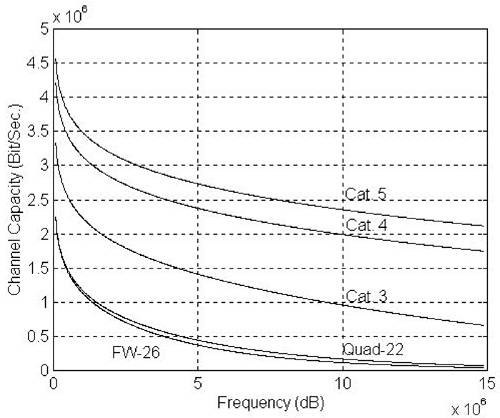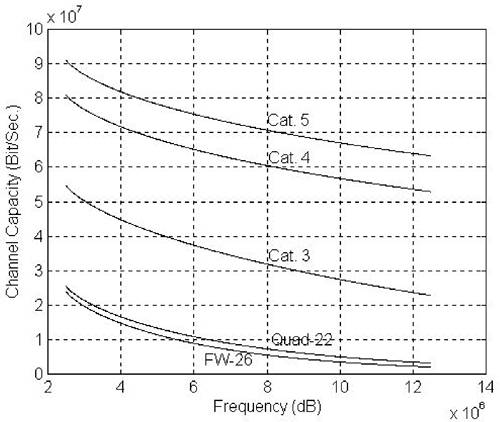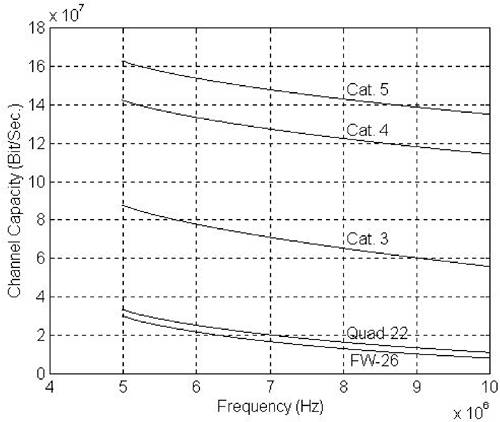2.5 Channel Capacity
| Channel capacities for a twisted pair cable or in-house wiring can be calculated against background noise and NEXT. The background noise for the twisted pair cable and in-house wiring environment is about 140 dBm/Hz. The received signal power depends on the transmit signal power and the insertion loss of a twisted pair cable or in-house wiring. The transmit signal power is limited by the radiation from the nearby electromagnetic field strength. Between 1.705 and 30 MHz, the field strength is 29.5 dBµV/m at a distance of 30 m. Assuming an RFI loss value of 40 dB, the allowed power within a 9-kHz bandwidth over a twisted pair cable or in-house wiring is calculated as Equation 2.57
The PSD within a 9-kHz bandwidth is therefore about 40 dBm/Hz. The total allowed power for a signal with a bandwidth wider than 9 kHz is about 13 dBm. At a PSD of 40 dBm/Hz, the bandwidth is about 180 kHz. Allowed PSD of signals with different bandwidths are summarized in Table 2.6. Channel capacity is defined as the maximum throughput at which a particular channel can be used to provide reliable communications. Errors might occur but they can be corrected, in theory, if the transmission throughput is under the channel capacity limit. Extensive channel and error correction codings are necessary to combat effects of distortion and noise when the transmission throughput is pushed near the channel capacity limit. At a particular frequency, the channel capacity can be calculated according to Equation 2.58
where S is the received signal power, N is the noise power, and the channel capacity C is expressed in terms of bits per hertz. The S/N is expressed in terms of power ratio. When the S/N is a constant over a frequency band, the channel capacity of that frequency band can be calculated according to Equation 2.59
where B is the bandwidth of the channel measured in hertz. When the S/N is a variable over a frequency band, the channel capacity of that frequency band can be calculated according to Equation 2.60
where f1 and f2 are the lower and upper bounds of the frequency band. We will first calculate channel capacities for different types of cables of a number of signal bandwidths against a background white noise of 140 dBm/Hz. The lower bound starts at 1.705 MHz, and the upper bound stops at 30 MHz. Figure 2.18 shows channel capacities of various twisted pair cables and in-house wirings of 100 m against the background white noise in a 9-kHz bandwidth for center frequencies up to 15 MHz. Channel capacities are between 260 and 300 kbps. Figure 2.18. 9-kHz Channel Capacity against a Background Noise of 140 dBm/Hz
Figure 2.19 shows channel capacity of various cables and in-house wirings also against the background white noise in a 180-kHz bandwidth for center frequencies up to 15 MHz. Channel capacities are between 5.1 and 5.8 Mbps. The capacity increase is almost proportional to the increase of bandwidth because the transmit PSDs are kept the same because the signal power for signals with a bandwidth wider than 9 kHz was allowed 13 dB more. The 20 times increase in bandwidth is the maximum allowed to meet the 13-dB allowance without reducing PSD. Figure 2.19. 180-kHz Channel Capacity against a Background Noise of 140 dBm/Hz
Figure 2.20 shows channel capacities against the background white noise in a 1-MHz bandwidth for center frequencies up to 14.5 MHz. To satisfy the power restriction, the signal PSD has been reduced by 7.5 dB to 47.5 dBm/Hz. The channel capacities are between 26 and 30 Mbps. Channel capacity increase is about 6 times, corresponding to a bandwidth increase of about 5.6 times and a proportional signal power decrease. Figure 2.20. 1-MHz Channel Capacity against a Background Noise of 140 dBm/Hz
Figure 2.21 shows channel capacities against the background white noise in a 5-MHz bandwidth for center frequencies up to 12.5 MHz. To satisfy the power restriction, the signal PSD has been further reduced by 7 dB to 54.4 dBm/Hz. Channel capacities are between 123 and 137 Mbps. The channel capacity increase is about 4.5 times, corresponding to a bandwidth increase of about 5 times and a proportional signal power decrease. Figure 2.21. 5-MHz Channel Capacity with a Background Noise of 140 dBm/Hz
Figure 2.22 shows channel capacities against the background white noise in a 10-MHz bandwidth for center frequencies up to 10 MHz. Again to satisfy the power restriction, the signal PSD has been further reduced by about 3 dB to 57.5 dBm/Hz. Channel capacities are between 242 and 259 Mbps. Channel capacity increase is about 1.9 times, corresponding to a bandwidth increase of about 2 times and a proportional signal power decrease. We see in general that a wider bandwidth signal results in a higher channel capacity under the constraint of using the same amount of signal power. Figure 2.22. 10-MHz Channel Capacity with a Background Noise of 140 dBm/Hz
We then calculate channel capacities against NEXT. Figure 2.23 shows channel capacities of various twisted pair cables and in-house wirings of 100 m against NEXT noise in a 9-kHz bandwidth for center frequencies up to 15 MHz. We see a wide range of channel capacity variations between different types of cables and wirings and at different frequencies. The channel capacity of the Category 5 twisted pair cable is more than 100 kbps, and the channel capacities of Quad and flat in-house wirings are less than 10 kbps at a frequency of 15 MHz. NEXT noise level is usually higher than that of background white noise. The NEXT noise level becomes much worse at high frequencies. Figure 2.23. 9-kHz Channel Capacity against NEXT
Figure 2.24 shows the channel capacity of various cables and in-house wirings against the NEXT noise in a 180-kHz bandwidth for center frequencies up to 15 MHz. While channel capacities for the Category 5 twisted pair cable are between 2 and 4.5 Mbps, they are well below 1 Mbps for Quad and flat in-house wirings especially at high frequencies. The proportionality still exists between increases of signal bandwidth and channel capacity. Figure 2.24. 180-kHz Channel Capacity against NEXT
Figure 2.25 shows channel capacities against NEXT noise in a 1-MHz bandwidth for center frequencies up to 14.5 MHz. Again, to satisfy the power restriction, the signal PSD has been reduced by 7.5 dB to 47.5 dBm/Hz. Channel capacities are between 10 and 20 Mbps for Category 4 and Category 5 twisted pair cables. Channel capacities for in-house wirings are below 10 Mbps for all frequencies and below 5 Mbps when frequency exceeds 2 MHz. Figure 2.25. 1-MHz Channel Capacity against NEXT
Figure 2.26 shows channel capacities against NEXT noise in a 5-MHz bandwidth for center frequencies up to 12.5 MHz. The signal PSD has been further reduced by 7 dB to 54.4 dBm/Hz to satisfy the power restriction. Channel capacities are between 50 and 90 Mbps for Category 4 and Category 5 twisted pair cables. Channel capacity increase is about 5 times, corresponding to a bandwidth increase of about 5 times and a proportional signal power decrease. Channel capacities for in-house wirings are below 25 Mbps for all frequencies and below 10 Mbps when center frequencies exceed 6 MHz. Figure 2.26. 5-MHz Channel Capacity against NEXT
Figure 2.27 shows channel capacities against NEXT noise in a 10-MHz bandwidth for center frequencies up to 10 MHz. The signal PSD has been further reduced by about 3 dB to 57.5 dBm/Hz. Channel capacities are between 110 and 170 Mbps for Category 4 and Category 5 twisted pair cables. Channel capacity increase is about 2 times, corresponding to a similar bandwidth increase and a proportional signal power decrease. Channel capacities are between 10 and 30 Mbps for in-house wirings. Figure 2.27. 10-MHz Channel Capacity against NEXT
Overall, while the channel capacities of Category 4 and Category 5 twisted pair cables against background white noise are at least twice that of those against NEXT noise, the channel capacities of in-house wirings against background white noise are at least 10 times that of those against NEXT noise. |
EAN: 2147483647
Pages: 97

